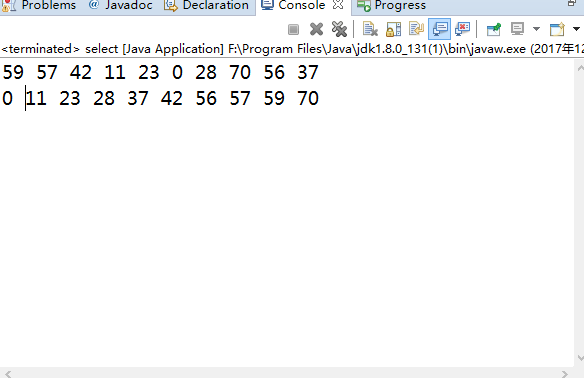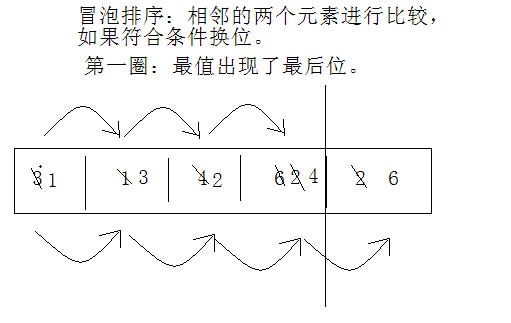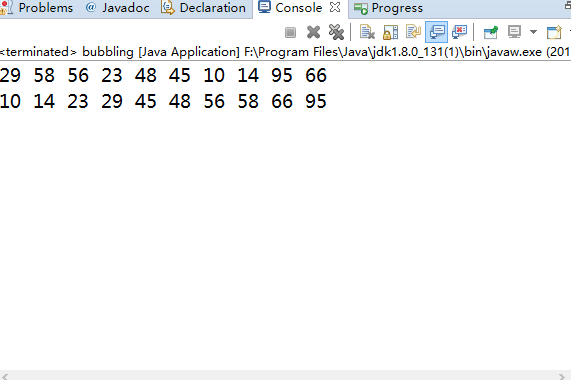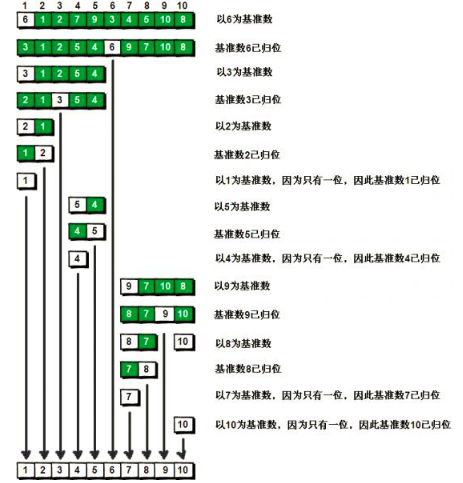由于刚学Java不久,所学知识有限,所以我只能谈谈我自己对于这三种算法的初步见解,不足之处请各位大佬不吝指教。
在这最近的学习中我了解到了选择,冒泡,快速三种排序算法。在这三种算法中我认为比较简单易懂的是选择排序和冒泡排序。所以首先我先来讲一下我对这两种排序算法的一点理解。
1.选择排序:
选择排序(Selection sort)是一种简单直观的排序算法。它的工作原理是每一次从待排序的数据元素中选出最小(或最大)的一个元素,存放在序列的起始位置,直到全部待排序的数据元素排完。如下图所示:

从第一个数组元素开始,分别与后面的数组元素相比较,当一轮比完后将最值(最大值或最小值)放在0号角标的位置,然后第二轮从1号角标开始,重复第一轮的动作。之后的步骤与之类似。关于选择排序我写了一个示例:
1 package algorithms; 2 /** 3 * 选择排序 4 * @author 晓煜 5 * 6 */ 7 public class select { 8 9 public static void main(String[] args) { 10 // TODO Auto-generated method stub 11 int []number=new int[10];//定义一个整型数组长度为10 12 for (int i = 0; i < 10; i++) {//循环10次 13 number[i]=(int)(Math.random()*100);//产生10个0~100的随机数依次放入数组 14 System.out.println(number[i]);//打印出没排序之前的数组 15 } 16 for (int i = 0; i < number.length; i++) { 17 for (int j = i+1; j < number.length; j++) { 18 if (number[i]>number[j]) {//比较数组元素 19 int max=number[i];//从小到大排序 20 number[i]=number[j]; 21 number[j]=max; 22 } 23 } 24 } 25 for (int i = 0; i < number.length; i++) { 26 System.out.print(number[i]+" ");//打印排序后的数组 27 } 28 } 29 30 }
运行结果如下:

2.冒泡排序:
冒泡排序(Bubble Sort),是一种计算机科学领域的较简单的排序算法。
它重复地走访过要排序的数列,一次比较两个元素,如果他们的顺序错误就把他们交换过来。走访数列的工作是重复地进行直到没有再需要交换,也就是说该数列已经排序完成。
这个算法的名字由来是因为越大的元素会经由交换慢慢“浮”到数列的顶端,故名。
如下图所示:

代码示例:
1 public class bubbling { 2 3 public static void main(String[] args) { 4 // TODO Auto-generated method stub 5 int []number=new int[10]; 6 for (int i = 0; i < 10; i++) { 7 number[i]=(int)(Math.random()*100); 8 System.out.println(number[i]); 9 } 10 for (int i = 0; i < number.length; i++) { 11 for (int j = 0; j < number.length-i-1; j++) { 12 if (number[j]>number[j+1]) { 13 int max=number[j]; 14 number[j]=number[j+1]; 15 number[j+1]=max; 16 } 17 } 18 } 19 for (int i = 0; i < number.length; i++) { 20 System.out.print(number[i]+" "); 21 } 22 } 23 24 }
因为这个代码的形式和上面的选择排序没有多大区别,所以就不详细介绍注释了。
运行结果如下

3.快速排序:
快速排序因为其比较方式与上面的两种算法要复杂许多,所以不是那么的好理解,先放上基本的概念:
快速排序(Quicksort)是对冒泡排序的一种改进。
它的基本思想是:通过一趟排序将要排序的数据分割成独立的两部分,其中一部分的所有数据都比另外一部分的所有数据都要小,然后再按此方法对这两部分数据分别进行快速排序,整个排序过程可以递归进行,以此达到整个数据变成有序序列。
概念还是不如图好理解所以我抠了张比较好理解的图过来:

代码示例:
1 package algorithms; 2 3 public class QuickSort { 4 public static void main(String[] args) { 5 // long start=System.currentTimeMillis(); 6 int []nums=new int[10]; 7 for (int i = 0; i < nums.length; i++) { 8 nums[i]=(int)(Math.random()*100); 9 System.out.print(nums[i]+" "); 10 } 11 12 System.out.println(" "); 13 //应用快速排序方法 14 quickSort(nums, 0, nums.length-1); 15 // 显示排序后的数组 16 for(int i = 0; i < nums.length; ++i) { 17 System.out.print(nums[i] + ","); 18 } 19 System.out.println(""); 20 System.out.println(" "); 21 // long end=System.currentTimeMillis();//结束时间 22 // System.out.println("毫秒时间:"+(end-start));//运行时间 23 } 24 25 /**快速排序方法*/ 26 public static void quickSort(int[] a, int lo0, int hi0) { 27 int lo = lo0; //相当于i,左 28 int hi = hi0; //相当于j, 右 29 if (lo >= hi) // 判断是否到中间了 30 return; 31 //确定指针方向的逻辑变量,也就是从左搜索还是向右搜索 32 boolean transfer=true; 33 34 while (lo != hi) { 35 if (a[lo] > a[hi]) { 36 //交换数字 37 int temp = a[lo]; 38 a[lo] = a[hi]; 39 a[hi] = temp; 40 //决定下标移动,还是上标移动 41 transfer = (transfer == true) ? false : true; 42 } 43 //将指针向前或者向后移动 44 if(transfer) 45 hi--; 46 else 47 lo++; 48 //显示每一次指针移动的数组数字的变化 49 50 for(int i = 0; i < a.length; ++i) { 51 System.out.print(a[i] + ","); 52 } 53 System.out.print(" (lo,hi) = " + "(" + lo + "," + hi + ")"); 54 System.out.println(""); 55 } 56 //将数组分开两半,确定每个数字的正确位置 57 lo--; 58 hi++; 59 quickSort(a, lo0, lo); 60 quickSort(a, hi, hi0); 61 } 62 }
代码运行效果:


以上是整个排序的过程,lo,hi代表的是两个角标,每次都取第一位数作为基数。
如果需要了解这三种算法的排序的效率,并自己亲自实验一下可以使用以下简单的测量运行时间的小程序:
1 package algorithms; 2 3 public class getTime { 4 5 public static void main(String[] args) { 6 // TODO Auto-generated method stub 7 8 } 9 10 } 11 abstract class time{//获取程序运行时间 12 public final void GetTime(){ 13 long start=System.currentTimeMillis();//开始时间 14 Run(); 15 long end=System.currentTimeMillis();//结束时间 16 System.out.println("毫秒时间:"+(start-end));//运行时间 17 } 18 public abstract void Run(); 19 20 }
以上是我第一次水博客,请各位原谅我的失误,与不足。
学习java时间不长,多多包涵。